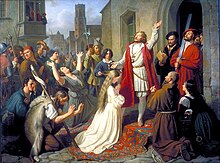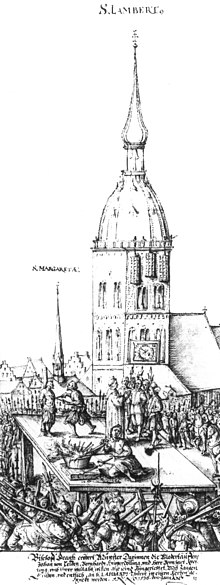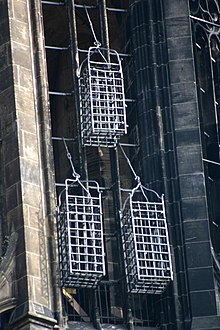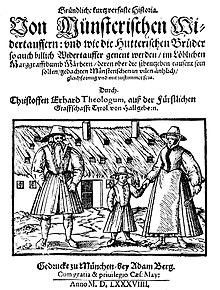Anabaptist Empire of Munster

The Anabaptist Empire of Münster in the 1530s in Münster ( Westphalia ) was the increasingly radicalizing rule of reformatory parts of the city around the preacher Bernd Rothmann towards an apocalyptic - chiliastic regime that was under the impression of military encirclement and starvation by Catholics and allies Protestant troops resorted to overt violence. It ended in June 1535 with the reconquest of the city by the Protestant Prince-Bishop Franz von Waldeck .
Within the Anabaptism existing in the German-speaking and Dutch areas, the Anabaptist Empire of Münster assumed a special role.
Historical and theological context
The Anabaptist movement developed in the 1520s from former companion Huldrych Zwingli ( Zurich ) as a radical branch of the Reformation in different simultaneous development strands in Switzerland, Austria, South and Central Germany and later also something in the Lower Germany. Here it was Melchior Hofmann who brought Anabaptist teachings from the spiritualistic end-time milieu of Strasbourg to the more northerly regions. Hofmann first appeared as an Anabaptist preacher in Emden in 1530 , and later in Amsterdam . Through him, Anabaptist teachings and religious communities spread in the Low German region (Melchiorites). The Amsterdam municipality was later taken over by Jan Mathys .
With his idea of a theocratic intermediate empire before the return of Christ after a military conflict between the emperor and evangelical cities, Hofmann exerted a strong influence on the theology of the Münster movement. He is considered an indirect theological pioneer of the Münster Anabaptist empire. The apocalyptic - chiliastic message of his writings fell here partly on fertile ground. The socio-economic situation of the simple population of the Münsterland as well as the "toughest persecutions " that they had to endure from all sides opened the believers to end-time views.
story
Reformation movement in Münster
The fact that the city of Münster became the scene of the Anabaptist Empire was due, among other things, to the inner-city disputes between the hereditary families , craftsmen and the Roman Catholic clergy that exclusively ruled this city , which culminated in the uprising of 1525. The ruling city councils, e.g. B. the respected but Catholic-minded mayor Everwin II of Droste zu Handorf and his nephew Johann VII Droste zu Hülshoff , who were also lay judges in the Überwasser district, tried to mediate, but failed, resigned their office in 1530 and left the city .
From 1531 the craft guilds joined the still young evangelical movement, which was mainly represented in Münster by Bernd Rothmann . Rothmann was banned from preaching several times by the Münster cathedral chapter and finally expelled from the country. Rothmann's now extensive following, including wealthy citizens, prevented this. Rothmann also ignored the admonitions of Martin Luther and Philipp Melanchthon . By the summer of 1532, a 70-member committee of the municipal guild assembly had evangelical preachers in all city churches. This committee, which in Münster had a right of co-determination vis-à-vis the elected city council, determined Münster's policy until 1533, when the city council also became Protestant.
The Münster Reformation movement did not join the Confessio Augustana formulated by the Lutheran imperial estates in 1530 , which is why it received little support from territories that had already become Lutheran. The movement was able to prevail, however, as the office of Bishop of Münster and Osnabrück and thus the sovereign was filled three times in quick succession. Franz von Waldeck , who himself leaned towards the Reformation, only established himself permanently in the early summer of 1532 and was only able to take action against Münster from then on. Dietrich von Merveldt († 1564), Drost zu Wolbeck , made a fruitless attempt to restore order in the city with a peasant contingent. First, Waldeck imposed a trade ban on the city and had cattle confiscated from the citizens of Münster. In return, on December 25, 1532, people from Münster attacked episcopal advisers, including the former mayor Everwin II von Droste zu Handorf and his relatives, who were advising further measures against the city in Telgte , and took them hostage to Münster. In this situation, a compromise was reached with the mediation of Philip of Hesse : the prince-bishop accepted the evangelical preachers in the city, but the churches and monasteries had to stick to the Catholic rite. The heirs received influence again.
Dispute in the citizenry; Radicalization of Bernd Rothmann
During this time the city council was restructured. Individual Catholic members had resigned as early as 1532, in the elections in March 1533 the body became completely Protestant. As one of the first decisions, the council commissioned Bernd Rothmann to work out a new service order. Rothmann had meanwhile radicalized and joined the Anabaptist movement . The Protestant movement in the city split over Rothmann's demand for adult baptism . The council opposed this demand, closed all churches and tried to build a Lutheran ministry. In return, he did not have a majority in the population who still supported Bernd Rothmann's position. An attempt to recatholize the Catholic minority in autumn 1533 was unsuccessful.
Protestants and Dutch Anabaptists move in
At this point in time, Protestants from the near and far area were already coming to the city, including many Anabaptists from the Netherlands. In the summer of 1533, the 23-year-old Jan van Leiden , who later became the “King” of Münster, was in the city for the first time for two months. He first returned to the Netherlands and was baptized again as an adult by Jan Mathys , the most important “prophet” of the Dutch Anabaptist movement. Mathys also gained increasing influence on the Anabaptist sympathizers in Münster. In January 1534 he sent Jan van Leiden to the city as his envoy.
At the same time, adult baptisms began in the city. Since the Anabaptists rejected infant baptism as unbiblical, Christians who had already been baptized were baptized again during these adult baptisms. Such "rebaptisms" contradicted the creed ("We confess the one baptism for the forgiveness of sins.") And thus the law of the Holy Roman Empire , which gave Prince-Bishop Franz von Waldeck the opportunity to take action against the city again. His request to the city council to hand over the Anabaptists was rejected by the city council. However, the panel also refused to officially support the Anabaptists. With this, the city council had lost both the legitimacy of the sovereign and the support of the residents.
Building the Anabaptist kingdom; Jan Mathys
In February 1534, Jan Mathys appeared in the city and took the lead in the Anabaptist movement. On February 23, 1534, the Anabaptists prevailed in the regular election of the council and thus ruled Münster. A few weeks earlier, most of the remaining Catholics and many non-Anabaptist Protestants had left the city. The remaining followers of these two faiths were either re-baptized or expelled from Münster after the election. Buildings of the displaced were occupied or devastated.
In the following weeks, a radical restructuring of the structures in the city began. During an iconoclasm in the churches, the Anabaptists destroyed everything that was reminiscent of the saints and the clergy, and in the process destroyed many art treasures. They confiscated property in the city, led among other things to the community property of the Jerusalem church ajar community property and left the city archives as archives of Erbmänner burn. This radicalism led to renewed clashes. Above all, the increasing end-time expectation of the prophets met with rejection. For Easter 1534 Jan Mathys announced the appearance of Jesus Christ in the city. During these developments Franz von Waldeck had closed a siege ring around the city. When the appearance of Christ did not materialize, Jan Mathys and some of his followers moved to the town on Easter day, where he was killed.
Further radicalization; Jan van Leiden
From this point on, Jan van Leiden was the head of the Münster Anabaptists. The movement continued to radicalize under him. Although he abolished the torture in common use at the time before executing a death sentence, he often carried out death sentences personally, including that of his own wife, who had criticized his luxury. Polygyny was introduced in the city in the summer of 1534 due to the considerable surplus of women - among the Munster Anabaptists there were almost three times as many women as men - even though the Anabaptists initially spoke out in favor of strict moral watchfulness. Jan van Leiden himself took 16 wives during the Anabaptist Empire. In September the city fended off a storm attempt by the besiegers, whereupon Jan van Leiden was named "King John I." These fundamental changes in the city were controversial among the population, also in view of the threat from outside, but oppositional views were suppressed by van Leiden and his supporters. Also in September “missionaries” were sent to neighboring cities. However, these were either intercepted by episcopal troops or picked up in their target cities. Those who could preach had little success. Only in Warendorf did the Anabaptists take control of the city for a week , but were quickly beaten by the bishop's soldiers. In October 1534, a request for help to the Dutch Anabaptist movement, which was also under pressure there, also failed.
Siege and recapture of Münster
The militancy of the Munster Anabaptists resulted, among other things, from the militarily hopeless situation within the city walls. It is true that they had placed cannons on the church towers and made successful failures. But the troops, which Franz von Waldeck had subordinated to the experienced Wirich V. von Daun-Falkenstein and which consisted of both knights and mercenaries , surrounded the city walls with the help of seven fortified camps and their crews. The mounted troops had the task of sealing off the traffic routes to Munster. The siege of the city by united royal armies of Old Believer and Protestant princes soon led to a famine. The suffering was so great that even the white lime paint of the churches is said to have been scraped off, dissolved in water and distributed as milk.
On the night of June 24th to 25th, 1535, two defectors led episcopal soldiers through the Kreuztor into the city, which enabled further troops to penetrate into Münster the following day after fighting. A bloodbath ended the Anabaptist kingdom. Around 650 defenders were killed and the women were driven out of the city. Main preacher Bernd Rothmann and "Reich Chancellor" Heinrich Krechting managed to escape. In the weeks that followed, the Anabaptists of both sexes who were still alive, with the exception of Jan van Leiden, Bernd Krechting and Bernd Knipperdolling, were executed.
Condemnation and execution of the leaders
The three remaining heads of the Anabaptists, including the “Anabaptist King” Jan van Leiden , whom the episcopal Drost zu Wolbeck , Dirk von Merveldt had captured himself, were first shown around the monastery for six months and asked about their offenses with and without torture. On January 6, 1536, they were sentenced to death in Wolbeck in accordance with the Anabaptist mandate of the Diet of 1529 and the Constitutio Criminalis Carolina , introduced in 1532 , and tortured to death on January 22nd at the foot of the Lamberti Church on the Prinzipalmarkt . Jan van Leiden, Bernd Krechting and Bernd Knipperdolling had their tongues torn out with red-hot pliers, their bodies shredded and stabbed to death after four hours. Their corpses were hung up on the tower of the Lambertikirche in iron baskets actually intended for the transport of prisoners , "that they served as a warning and a horror to all restless spirits that they would not attempt or dare to do something similar in the future." The baptismal baskets still hang on the church today . After the old church tower had become dilapidated, the baskets were removed on December 3, 1881, after completion of the new church tower, they were re-attached to the south side on September 22, 1898. The torture instruments are in the Münster City Museum .
Artistic reception
theatre
- Eli Marcus and others: Jan van Leyden, King of the Anabaptists or Libbetken Klutenkemper's Bridal Trip or The Münster Begging Student. Low German carnival game. 1st, 2nd ed. Osnabrück 1884; 3rd edition Bielefeld 1889.
- Eli Marcus and others: The great prophet Jan van Leyden or Siske! or Holland in Nauth! Plattdt. Mardi Gras. Munster 1893; New edition: Münster 1925.
- Friedrich Dürrenmatt : It is written , a drama; First performance on April 19, 1947, Schauspielhaus Zurich.
- Friedrich Dürrenmatt: The Anabaptists , a comedy in two parts; World premiere on March 16, 1967, Schauspielhaus Zurich.
- Dirk Spelsberg: Heart of Freedom ; First performance for the inauguration of the theater in the pump house in Münster 1985.
- Mirko Borscht and others: Kristus - Monster Of Münster ; based on the novel Kristus by Robert Schneider ; World premiere on January 7, 2011 at the Lower Saxony State Theater in Hanover.
- José Saramago et al .: In nomine dei 1st edition Lisbon 1993.
Opera and music
- Giacomo Meyerbeer : Le prophète (opera), first performance in Paris 1849, text: Eugène Scribe , German first performance in Hamburg under the title Der Prophet 1850.
- Divara - Wasser & Blut , music: Azio Corghi , commissioned composition for the 1200th anniversary of Münster, world premiere on October 31, 1993 in Münster
- Annette von Droste-Hülshoff : The Anabaptists (approximately between 1837 and 1839), only musical motifs preserved
Movies
- Rules of the game for an Anabaptist film , (Italy / Germany 1976, director: Georg Brintrup ). The film contrasts the historical situation in the city of Münster at the time of the Anabaptist Empire with the contemporary situation [in Münster] in the 1970s (using the example of four female educators who were banned from professions )
- King of the last days : The story of the Anabaptists in Münster , two-part TV film, (Germany 1993), director: Tom Toelle
- The Anabaptists of Münster - A story from the time of the Reformation , [Germany 2017], director: Mark Lorei, ed. from the LWL media center for Westphalia on the DVD "Places of remembrance in Münster. The Anabaptists / The Peace of Westphalia
literature
- Adolf Stern : The Anabaptists. Historical novella. Weber, Leipzig 1866.
- Hermann Homann: Three cages on the tower. The rise and fall of the Anabaptist Empire in Münster in 1534/35. Coppenrath, Münster 1977, ISBN 3-920192-25-7 .
- Friedrich Reck-Malleczewen : Bockelson. Story of a mass madness. Schützen, Berlin 1937. New editions: Droemer, Wiesentheid 1946; Goverts, Stuttgart 1968 (with a foreword by Joachim Fest ). ( Historical novel; the Anabaptist Empire of Münster as an allegory of the mass madness of the Nazi dictatorship. )
- Franz Theodor Csokor : The key to the abyss, novel of a time , Paul Zsolnay Verlag 1955
- Rosemarie Schuder : The Enlightened or The Image of Poor Lazarus in Münster in Westphalia, also called the terror of love by the less fearful. Union, Berlin (East) 1968 / Tribüne, Berlin 1986, ISBN 3-7303-0028-8 .
- Pierre Barret, Jean Noël Gurgand: The King of the Last Days. The gruesome and exemplary history of the Anabaptists in Münster 1534–1535 . (Original title: Le roi des derniers jours , translated by Michèle Schönfeldt). Kabel, Hamburg 1982, ISBN 3-921909-41-4 .
- Norbert Johannimloh : The second Judith. Novel. Haffmans, Zurich 2000, ISBN 3-251-00486-7 (Three women from the time of the Anabaptists).
- Luther Blissett , Ulrich Hartmann: Q . 3. Edition. Piper, Munich / Zurich 2003 (A historical novel about the Reformation and the Anabaptist movement in Germany in the 16th century).
- Robert Schneider : Kristus . Novel. Structure, Berlin 2004, ISBN 3-35103-013-4 .
- Antonio Orejudo : Fire Baptist. Roman (Original title: Reconstrucción. Tusquets Ed., Barcelona 2005, translated by Christian Hansen), Knaus, Munich 2006, ISBN 978-3-8135-0266-4
- Dietmar Krüger: Kim Luna - The Curse of the Anabaptist Epsilon, Nordhastedt 2012, ISBN 978-3-86693-155-8 (The comic also deals with the Anabaptist story, although not entirely according to reality).
- Iny Lorentz: Flammen des Himmels Roman, Knaur, Munich 2013, ISBN 978-3426504093
radio play
- Norbert Johannimloh: radio play Küenink un Duohlen un Wind (WDR 1964; RB, NDR, NECV Hilversum under the title Koning in een kooi ) describes how Jan van Leiden and his comrades hang in their cages on the tower; with broken limbs but still alive and making plans while the jackdaws lurk for their meal.
- In 2005, the WDR published a radio play of more than three hours on Robert Schneider's novel Kristus, directed by Jörg Schlueter and adapted from Christoph Busch. Jan was spoken by Martin Bross , Bernd Rothmann by Ernst August Schepmann and Knipperdolling by Udo Schenk . The CD edition was published by Audio-Verlag.
- Dan Carlin: Hardcore History 48: Prophets of Doom (2013)
Scientific publications
Sources and contemporary representations
- Hermann von Kerssenbrock: The Anabaptists' frenzy, which destroyed Münster, the famous capital in Westphalia , 1568.
- Carl Adolf Cornelius (Ed.): Reports of the eyewitnesses about the Munster Anabaptist empire . Aschendorff, Münster 1853, reprint Münster 1983, ISBN 3-402-05230-X .
- Robert Stupperich (Ed.): Writings of the Münster Anabaptists and their opponents . 3 volumes, Aschendorff, Münster 1970–1980, ISBN 3-402-05831-6 (volume 2), ISBN 3-402-05832-4 (volume 3).
- Christopher Mackay (translator and editor): False Prophets and Preachers: Henry Gresbeck's Account of the Anabaptist Kingdom of Münster. Pennsylvania State University Press, University Park 2016, ISBN 978-1-61248-142-5 .
Representations
- Thorsten Albrecht, Barbara Rommé (ed.): The Kingdom of the Anabaptists . Vol. 1: Reformation and rule of the Anabaptists in Münster . Vol. 2: The Munster Anabaptists in the mirror of posterity . Stadtmuseum, Münster 2000 (catalog for the exhibition in the Stadtmuseum Münster, September 17, 2000 to March 4, 2001).
- Claus Bernet: Built Apocalypse. The utopia of the Heavenly Jerusalem in the early modern period , Zabern, Mainz 2007, ISBN 978-3-8053-3706-9 .
- Richard van Dülmen: The Anabaptist Empire at Münster: 1534–1535; Reports and documents , dtv 4150 (Scientific Series), Munich 1974, ISBN 3-423-04150-1
- Richard van Dülmen : Reformation as a revolution. Social Movement and Religious Radicalism in the German Reformation . dtv 4273 (Scientific Series), Munich 1977, ISBN 3-423-04273-7 .
- Hans-Jürgen Goertz : The Anabaptists - History and Interpretation . CH Beck, Munich 1980, 2nd edition 1988, ISBN 3-406-31660-3
- Horst Karasek : The Anabaptist Commune. Report from the liberated and besieged city of Münster 1534. Wagenbach, Berlin 1977, ISBN 3-8031-2016-0 .
- Karl-Heinz Kirchhoff: The Anabaptists in Münster 1534/35. Investigations into the scope and social structure of the movement . Aschendorff, Münster 1973, ISBN 3-402-05220-2 .
- Karl-Heinz Kirchhoff: The phenomenon of the Anabaptist empire at Münster 1534/35 . In: Franz Petri et al. (Ed.): The Westphalia area . Vol. 6, Lf. 1. Aschendorff, Münster 1989, pp. 278-413.
- Ralf Klötzer: The Anabaptist rule of Münster. Urban Reformation and World Renewal . Aschendorff, Münster 1992 ISBN 3-402-03779-3 ( Reformation history studies and texts . Vol. 131).
- Hubertus Lutterbach : The way into the Anabaptist kingdom of Münster. A struggle for the holy city . Dialogverlag, Münster 2006, ISBN 3-933144-08-6 ( History of the Diocese of Münster . Vol. 3)
- Gunther List: Chiliastic Utopia and Radical Reformation. The renewal of the millennium idea in the 16th century . Humanist library series. Wilhelm Fink, Munich 1973
- Thomas Seifert: The Anabaptists at Münster . Agenda, Münster 1993 ISBN 3-929440-18-0
Representations of the reception history
- Jan Matthias Hoffrogge: The "Anabaptist myth". Münster's controversial place of memory. Aschendorff Verlag, Münster 2018, ISBN 978-3-402-13121-3 ( Small writings from the Münster City Archives. Vol. 15).
- Karl-Heinz Kirchhoff: The "Anabaptist cages" in Münster . Aschendorff Verlag, Münster 1996, ISBN 978-3-402-05355-3 .
- Katja Schupp: Between fascination and disgust: the Anabaptist empire of Münster. For reception in history, literature, journalism and popular representation from the end of the 18th century to the Third Reich . Lit Verlag, Münster and others 2002, ISBN 3-8258-4932-5 ( Edition Kulturregion Münsterland , Vol. 1).
Exhibitions
- 1982/1983: The Anabaptists in Münster. City Museum Münster ; Catalog of the opening exhibition. 5. verb. and exp. Edition, Aschendorf, Münster 1986, ISBN 3-402-05952-4 .
- 2000: The Kingdom of the Anabaptists. City Museum Münster ; Catalog: Thorsten Albrecht, Barbara Rommé (Hrsg.): The Kingdom of the Anabaptists . Vol. 1: Reformation and rule of the Anabaptists in Münster . Vol. 2: The Munster Anabaptists in the mirror of posterity . Stadtmuseum, Münster 2000 (catalog for the exhibition in the Stadtmuseum Münster, September 17, 2000 to March 4, 2001).
Web links
- "The wedderdoeper eidt" / oath of the Münster Anabaptists
- Carsten Fischer: The Anabaptists in Münster (1534/35) - Law and Constitution of a Chiliastic Theocracy - , in forum historiae iuris , First European Internet Journal for Legal History (2004)
- ZeitZeichen : January 5th, 1534 - Anabaptists move into Münster
Individual evidence
- ↑ George Huntston Williams : The Radical Reformation; Sixteenth Century Essays and Studies , Truman State University Press 1992, ISBN 0940474158
- ↑ Hans-Jürgen Goertz : The Anabaptists. History and interpretation . Munich 1980. ISBN 3-406-07909-1 , p. 12f.
- ^ Klaus Deppermann, Hans-Jürgen Goertz: Hoffman, Hof (f) mann, Melchior. In: in mennlex.de. March 5, 2013, accessed August 6, 2019 .
- ^ Richard van Dülmen (ed.): The Anabaptist Empire in Münster 1534–1535. dtv Wissenschaftliche Reihe, Munich 1974, ISBN 3-423-04150-1 , p. 7
- ^ Hermann von Kerssenbrock : The Anabaptists' frenzy, which Munster, the famous capital in Westphalia, destroyed . 1568.
- ↑ Werner Freitag: Anabaptist Empire Münster - Polygamy and Theocracy. In: Q History. Retrieved on August 6, 2019 : “Sendung 04/2010 bei” and Auke Jelsma: De koning en de vrouwen , in: Gereformeerd theologische tijdschrift 75 (1975), pp. 82-107; but on a possible link between strict sexual morality and polygyny: James M. Stayer: Polygamy as 'inner-worldly asceticism'. New conceptions of marriage during the Reformation , in: Mennonitische Geschichtsblätter 37 (1980), pp. 24–41.
- ↑ These included the former mayor of Münster Johann VII. Droste zu Hülshoff and his son Heinrich I. von Droste zu Hülshoff with their brushwood (Wilderich von Droste zu Hülshoff: 900 years Droste zu Hülshoff , Verlag LPV Hortense von Gelmini, Horben 2019)
- ^ Thomas Seifert: The Anabaptists at Münster . agenda Verlag, Münster 1993, ISBN 3-929440-18-0 , p. 140.
- ↑ a b c Thomas Seifert: The Anabaptists at Münster . agenda Verlag, Münster 1993, ISBN 3-929440-18-0 , p. 142.
- ^ "Kristus" at the Hanover Theater: Desired career to be redeemer. In: noz.de. January 9, 2011, accessed August 6, 2019 .
- ↑ Georg Brintrup: Rules of the game for an Anabaptist film - The Anabaptist constitution and the enemies of the constitution in the FRG. In: brintrup.com. Retrieved August 6, 2019 .
- ↑ The Anabaptist Empire of Münster in the Internet Movie Database (English)
- ↑ Radio play Küenink un Duohlen un Wind in the Low German Bibliography and Biography (PBuB), [1] record Künink un Duohlen un Weind .



